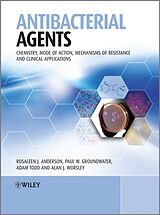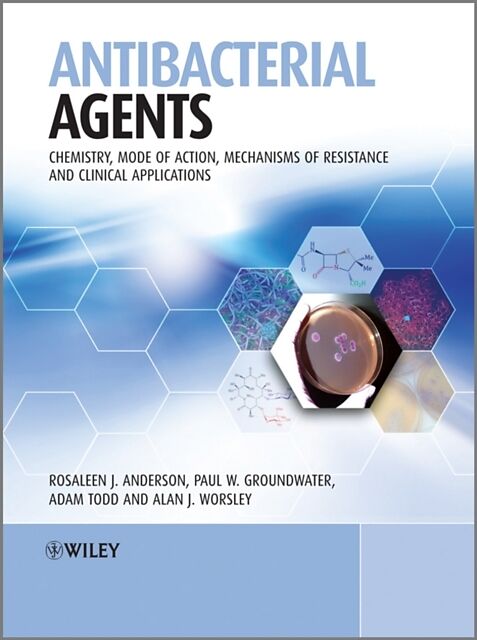Antibacterial Agents
Einband:
Kartonierter Einband (Kt)
EAN:
9780470972458
Untertitel:
Chemistry, Mode of Action, Mechanisms of Resistance and Clinical Applications
Genre:
Chemie
Autor:
Rosaleen (University of Sunderland) Anderson, Paul W. (University of Sydney) Groundwater, Adam (University of Sunderland) Todd, Alan (University of Sunderland) Worsley
Herausgeber:
Wiley-Blackwell
Auflage:
1. Auflage
Anzahl Seiten:
378
Erscheinungsdatum:
23.07.2012
ISBN:
978-0-470-97245-8
Informationen zum Autor Professor Rosaleen Anderson, Professor of Pharmaceutical Chemistry, Sunderland Pharmacy School, University of Sunderland, UK Professor Paul Groundwater, Professor of Medicinal Chemistry, Faculty of Pharmacy, The University of Sydney, Australia Dr Adam Todd, Senior Lecturer in Pharmacy Practice, Sunderland Pharmacy School, University of Sunderland, UK Dr Alan Worsley, Principal Lecturer in Pharmacy Practice, Sunderland Pharmacy School, University of Sunderland, UK Klappentext Antibacterial agents act against bacterial infection either by killing the bacterium or by arresting its growth. They do this by targeting bacterial DNA and its associated processes, attacking bacterial metabolic processes including protein synthesis, or interfering with bacterial cell wall synthesis and function.Antibacterial Agents is an essential guide to this important class of chemotherapeutic drugs. Compounds are organised according to their target, which helps the reader understand the mechanism of action of these drugs and how resistance can arise. The book uses an integrated "lab-to-clinic" approach which covers drug discovery, source or synthesis, mode of action, mechanisms of resistance, clinical aspects (including links to current guidelines, significant drug interactions, cautions and contraindications), prodrugs and future improvements. Agents covered include:* agents targeting DNA - quinolone, rifamycin, and nitroimidazole antibacterial agents* agents targeting metabolic processes - sulfonamide antibacterial agents and trimethoprim* agents targeting protein synthesis - aminoglycoside, macrolide and tetracycline antibiotics, chloramphenicol, and oxazolidinones* agents targeting cell wall synthesis - ß-Lactam and glycopeptide antibiotics, cycloserine, isonaizid, and daptomycinAntibacterial Agents will find a place on the bookshelves of students of pharmacy, pharmacology, pharmaceutical sciences, drug design/discovery, and medicinal chemistry, and as a bench reference for pharmacists and pharmaceutical researchers in academia and industry. Zusammenfassung Antibacterial agents act against bacterial infection either by killing the bacterium or by arresting its growth. They do this by targeting bacterial DNA and its associated processes, attacking bacterial metabolic processes including protein synthesis, or interfering with bacterial cell wall synthesis and function. Inhaltsverzeichnis Preface xiii SECTION 1 INTRODUCTION TO MICROORGANISMS AND ANTIBACTERIAL CHEMOTHERAPY 1 1.1 Microorganisms 3 Key points 3 1.1.1 Classification 3 1.1.2 Structure 4 1.1.3 Antibacterial targets 6 1.1.4 Bacterial detection and identification 17 1.1.5 Other than its mode of action, what factors determine the antibacterial activity of a drug? 25 1.1.6 Bacterial resistance 27 1.1.7 The 'post-antibiotic age'? 29 References 31 Questions 33 SECTION 2 AGENTS TARGETING DNA 35 2.1 Quinolone antibacterial agents 37 Key points 37 2.1.1 Discovery 37 2.1.2 Synthesis 39 2.1.3 Bioavailability 41 2.1.4 Mode of action and selectivity 44 2.1.5 Bacterial resistance 45 2.1.6 Clinical applications 47 2.1.7 Adverse drug reactions 50 2.1.8 Drug interactions 55 2.1.9 Recent developments 56 References 60 2.2 Rifamycin antibacterial agents 63 Key points 63 2.2.1 Discovery 63 2.2.2 Synthesis 65 2.2.3 Bioavailability 68 2.2.4 Mode of action and selectivity 69 2.2.5 Bacterial resistance 71 2.2.6 Clinical applications 71 2.2.7 Adverse drug reactions 77 2.2.8 Drug interactions 78 2.2.9 Recent developments 81 References 81 2.3 Nitroimidazole antibacterial agents 85 Key points 85 2.3.1 Discovery 85...
Autorentext
Professor Rosaleen Anderson, Professor of Pharmaceutical Chemistry, Sunderland Pharmacy School, University of Sunderland, UK Professor Paul Groundwater, Professor of Medicinal Chemistry, Faculty of Pharmacy, The University of Sydney, Australia Dr Adam Todd, Senior Lecturer in Pharmacy Practice, Sunderland Pharmacy School, University of Sunderland, UK Dr Alan Worsley, Principal Lecturer in Pharmacy Practice, Sunderland Pharmacy School, University of Sunderland, UK
Klappentext
Antibacterial agents act against bacterial infection either by killing the bacterium or by arresting its growth. They do this by targeting bacterial DNA and its associated processes, attacking bacterial metabolic processes including protein synthesis, or interfering with bacterial cell wall synthesis and function. Antibacterial Agents is an essential guide to this important class of chemotherapeutic drugs. Compounds are organised according to their target, which helps the reader understand the mechanism of action of these drugs and how resistance can arise. The book uses an integrated "lab-to-clinic" approach which covers drug discovery, source or synthesis, mode of action, mechanisms of resistance, clinical aspects (including links to current guidelines, significant drug interactions, cautions and contraindications), prodrugs and future improvements. Agents covered include: * agents targeting DNA - quinolone, rifamycin, and nitroimidazole antibacterial agents * agents targeting metabolic processes - sulfonamide antibacterial agents and trimethoprim * agents targeting protein synthesis - aminoglycoside, macrolide and tetracycline antibiotics, chloramphenicol, and oxazolidinones * agents targeting cell wall synthesis - ß-Lactam and glycopeptide antibiotics, cycloserine, isonaizid, and daptomycin Antibacterial Agents will find a place on the bookshelves of students of pharmacy, pharmacology, pharmaceutical sciences, drug design/discovery, and medicinal chemistry, and as a bench reference for pharmacists and pharmaceutical researchers in academia and industry.
Inhalt
Preface xiii SECTION 1 INTRODUCTION TO MICROORGANISMS AND ANTIBACTERIAL CHEMOTHERAPY 1 1.1 Microorganisms 3 Key points 3 1.1.1 Classification 3 1.1.2 Structure 4 1.1.3 Antibacterial targets 6 1.1.4 Bacterial detection and identification 17 1.1.5 Other than its mode of action, what factors determine the antibacterial activity of a drug? 25 1.1.6 Bacterial resistance 27 1.1.7 The 'post-antibiotic age'? 29 References 31 Questions 33 SECTION 2 AGENTS TARGETING DNA 35 2.1 Quinolone antibacterial agents 37 Key points 37 2.1.1 Discovery 37 2.1.2 Synthesis 39 2.1.3 Bioavailability 41 2.1.4 Mode of action and selectivity 44 2.1.5 Bacterial resistance 45 2.1.6 Clinical applications 47 2.1.7 Adverse drug reactions 50 2.1.8 Drug interactions 55 2.1.9 Recent developments 56 References 60 2.2 Rifamycin antibacterial agents 63 Key points 63 2.2.1 Discovery 63 2.2.2 Synthesis 65 2.2.3 Bioavailability 68 2.2.4 Mode of action and selectivity 69 2.2.5 Bacterial resistance 71 2.2.6 Clinical applications 71 2.2.7 Adverse drug reactions 77 2.2.8 Drug interactions 78 2.2.9 Recent developments 81 References 81 2.3 Nitroimidazole antibacterial agents 85 Key points 85 2.3.1 Discovery 85 2.3.2 Synthesis 86 2.3.3 Bioavailability 86 2.3.4 Mode of action and selectivity 87 2.3.5 Mechanisms of resistance 89 2.3.6 Clinical applications 90 2.3.7 Adverse drug reactions 94 2.3.8 Drug interactions 95 2.3.9 Recent developments 96 References 97 Questions 101 SECTION 3 AGENTS TARGETING METABOLIC PROCESSES 103 3.1 Sulfonamide antibacterial agents 105 Key points 105 3.1.1 Discovery 105 3.1.2 Synthesis 107 3.1.3 Bioavailability 108 3.1.4 Mode of action and selectivity 111 3.1.5 Bacterial resistance 114 3.1.6 Clinical applications 115 3.1.7 Adverse…

Leider konnten wir für diesen Artikel keine Preise ermitteln ...
billigbuch.ch sucht jetzt für Sie die besten Angebote ...
Die aktuellen Verkaufspreise von 6 Onlineshops werden in Realtime abgefragt.
Sie können das gewünschte Produkt anschliessend direkt beim Anbieter Ihrer Wahl bestellen.
Loading...
Die aktuellen Verkaufspreise von 6 Onlineshops werden in Realtime abgefragt.
Sie können das gewünschte Produkt anschliessend direkt beim Anbieter Ihrer Wahl bestellen.
| # | Onlineshop | Preis CHF | Versand CHF | Total CHF | ||
|---|---|---|---|---|---|---|
| 1 | Seller | 0.00 | 0.00 | 0.00 |
